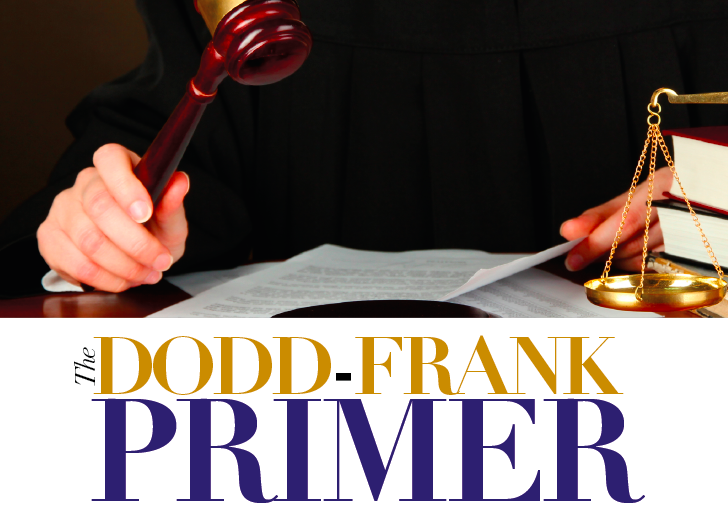
It is no doubt that the Dodd-Frank Wall Street Reform and Consumer Protection Act is the most comprehensive financial regulatory reform measure to be executed since The Great Depression. While the comprehensive bill consists of sixteen titles, with numerous provisions spelled out over thousands of pages, herein is an attempt to summarize key points, for a broad understanding of how Dodd-Frank relates to those of us participating in the housing economy.
The aim of the legislation is to secure the financial stability of the U.S. financial system by requiring accountability and transparency, to protect taxpayers by eliminating bailouts, to protect consumers from abusive lending practices, to create rules regarding executive compensation, to eliminate loopholes that led to 2008 economic recession, and more.
Financial Stability and Agency Oversight Reform
The numerous government agencies regulating financial institutions had varying standards led to some entities having little or no financial oversight, as compared to their peer financial firms which are classified according to different charters. The Dodd-Frank Act overhauls the existing agency oversight system in an attempt to maintain standards and visibility across all financial institutions and the agencies that govern them.
The Dodd-Frank Act changes the existing regulatory structure by establishing new oversight agencies while combining or eliminating others, to increase transparency of the regulatory process, and also to tighten oversight of specific financial institutions that pose ‘systemic risk’. The changes are purported to create economic stability, while a council was formed to act as a warning system to prevent future crashes.
Securitization Reform
New regulations affect the registration, disclosure, and reporting requirements for asset-backed securities and other structured finance products. Financial institutions are required to absorb more of the credit risk from securitizations, as well as implement accounting changes.
Before Dodd–Frank, investment advisers were not required to register with the SEC if they had less than 15 clients during the previous year, and did not present themselves to the public as an investment adviser. This exemption is now eliminated, thereby rendering numerous investment advisers, hedge funds, and private equity firms subject to the same requirements and larger institutions and investment groups. Certain non-bank financial institutions will be supervised by the Fed in the same manner as if they were a bank holding company.
Derivatives Regulation
Title VII, also known as the Wall Street Transparency and Accountability Act of 2010, demands a comprehensive regulatory reform on derivatives (derivatives are one of the three main financial instruments, the other two being equities such as stocks, and debt, such as bonds/mortgages). A derivative’s price is dependent upon (derived from) one or more underlying assets; its value is determined by fluctuations in the price of the underlying asset. The most common underlying assets include stocks, bonds, commodities, currencies, interest rates and market indexes. Most derivatives, such as futures contracts, forward contracts, options and swaps, are characterized by high leverage, and therefore should be considered to have systemic reach.
Mortgage and Banking
Dodd-Frank has an enormous impact on loan officers and mortgage brokers, requiring that all loan originators must now be licensed, registered, and issued a unique identifier. They are prohibited from charging more than three percent for all loan origination costs, which inhibits the ability of banks to offer mortgages on homes priced below $160,000. Restrictions apply to ensuring that borrowers meet debt-to-income requirements to prevent predatory lending, and interest-only and negative amortization loans are greatly limited.
Other rules were aimed at limiting debit card fees, such as interchange fees, protecting consumers while costing banks billions of dollars in transaction-related fees.
In response to the costs that the legislation places on banks, some banks have ended the practice of giving their customers free checking, and some small banks are no longer able to provide mortgages and car loans. Borrowers now have the ability to sue lenders for misjudging their ability to repay a loan, forcing smaller lenders to exit the mortgage lending market due to increased risk.
Credit Reporting Agencies
The Act established the SEC Office of Credit Ratings, since some credit rating agencies were accused of giving inaccurately positive investment ratings that helped contribute to the financial crisis. The goal of the office is to make certain that agencies provide reliable, accurate credit ratings.
The Volcker Rule
Named after former Federal Reserve Chairman Paul Volcker, the Volcker Rule was enacted based on the premise that speculative trading played a significant part in the financial crisis. The provision bans banks from making speculative trades with their own money, and limits their activity in certain private funds, as this activity may contribute to systemic risk). Therefore, most US banks are prohibited from proprietary trading, and covered institutions are prohibited from owning, sponsoring or investing in hedge funds or private equity funds.
Investor Protection
Unaware as to how auction rate securities and the secondary securities market functioned, many investors did not see the financial crisis coming. Numerous ponzi schemes were exposed, causing investors to lose millions, and eventually lose faith in those with custody of their funds. The provisions of the Dodd-Frank Act aim to boost investor protection and confidence, hoping to bring investors back to capital markets.
Compensation and Corporate Governance
In response to growing concerns over executive compensation in public companies, specific provisions now require new stock exchange listing and proxy statement standards, and further regulated disclosures for all public companies soliciting proxies or consents. As a result, corporations will have to change the structure of their compensation committees, as well as implement new governance and compensation policies.
Office of Minority and Women Inclusion
 The bill establishes an Office of Minority and Women Inclusion that promotes employment and contracting opportunities to address diversity matters. The offices will coordinate technical assistance to minority-owned and women-owned businesses and establish diversity requirements throughout various industries.
The bill establishes an Office of Minority and Women Inclusion that promotes employment and contracting opportunities to address diversity matters. The offices will coordinate technical assistance to minority-owned and women-owned businesses and establish diversity requirements throughout various industries.
Conclusion
There have been mixed reviews regarding the Dodd-Frank Act. Some critics argue that the legislation is too severe, that it limits job opportunities and prevents competition among financial institutions, however, we can perhaps all agree that industry needed oversight, overhaul and accountability.
The Act requires that regulators and oversight committees create 243 rules and conduct 67 studies, many of which are not complete. Therefore, it is premature to attempt to theorize on the efficacy of the legislature until the market begins to correct itself after the new regulations are in effect. You can expect more on the topic in future issues of N Magazine, as the Dodd-Frank Act begins to put down more solid roots in the U.S. economy.

 Login
Login
